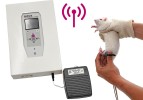Authors
P. Girard, Y. Pansart, J.-M. Gillardin.
Lab
Laboratoires Biocodex, Service de Pharmacologie, Compiègne, France.
Journal
Pharmacology Biochemistry and Behavior
Abstract
The objective of this study was to resolve discrepancies regarding the possible antinociceptive synergy between morphine and nefopam in animal models of pain. Firstly, we have examined the antinociceptive activity of nefopam, a nonopioid antinociceptive compound that inhibits monoamine reuptake, in pain models of allodynia and hyperalgesia induced by carrageenan injection, or skin and muscle incision of the rat hind paw. Single subcutaneous administration of nefopam at 30 mg/kg blocked carrageenan- and incision-induced thermal hyperalgesia, and weakly but significantly diminished carrageenan-induced tactile allodynia. A weaker dose of nefopam (10 mg/kg) only reduced carrageenan-induced tactile allodynia and incision-induced thermal hyperalgesia. Secondly, we assessed the usefulness of the coadministration of nefopam with morphine. Combination of a nonanalgesic dose of nefopam (10 mg/kg) with a nonanalgesic dose of morphine (0.3 or 1.0 mg/kg) completely inhibited carrageenan- or incision-induced thermal hyperalgesia, respectively. In carrageenan-induced tactile allodynia, coadministration of weak analgesic doses of nefopam (10 and 30 mg/kg) with a nonanalgesic dose (1 mg/kg) or moderately analgesic dose (3 mg/kg) of morphine significantly reduced or reversed allodynia, respectively. In conclusion, coadministration of nefopam with morphine enhances the analgesic potency of morphine, indicating a morphine sparing effect of nefopam.
BIOSEB Instruments Used:
SMALGO: SMall animal ALGOmeter (BIO-SMALGO)

 Douleur - Allodynie/Hyperalgésie Thermique
Douleur - Allodynie/Hyperalgésie Thermique Douleur - Spontanée - Déficit de Posture
Douleur - Spontanée - Déficit de Posture Douleur - Allodynie/Hyperalgésie Mécanique
Douleur - Allodynie/Hyperalgésie Mécanique Apprentissage/Mémoire - Attention - Addiction
Apprentissage/Mémoire - Attention - Addiction Physiologie & Recherche Respiratoire
Physiologie & Recherche Respiratoire
 Douleur
Douleur Système Nerveux Central (SNC)
Système Nerveux Central (SNC)  Neurodégénérescence
Neurodégénérescence Système sensoriel
Système sensoriel Système moteur
Système moteur Troubles de l'humeur
Troubles de l'humeur Autres pathologies
Autres pathologies Système musculaire
Système musculaire Articulations
Articulations Métabolisme
Métabolisme Thématiques transversales
Thématiques transversales SFN2024: Venez rencontrer notre équipe sur le stand 876 à Chicago
SFN2024: Venez rencontrer notre équipe sur le stand 876 à Chicago 